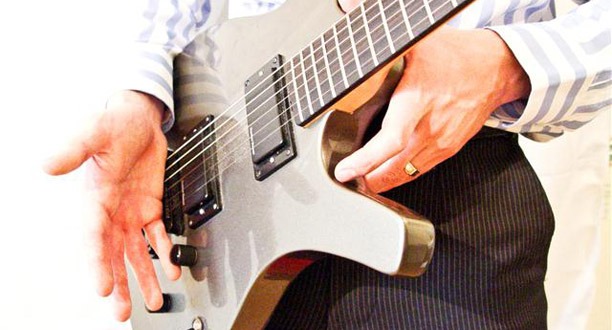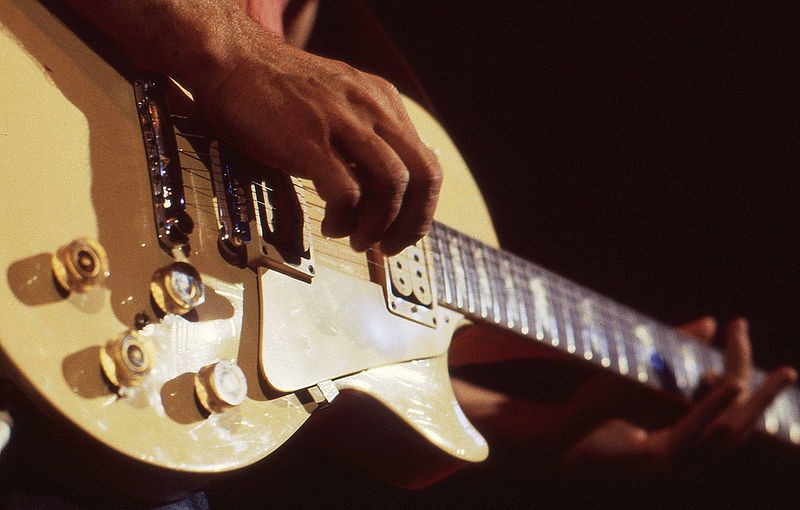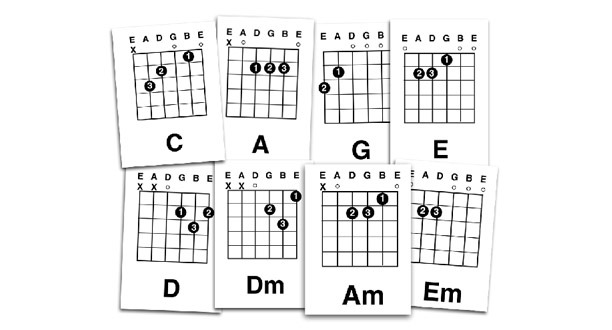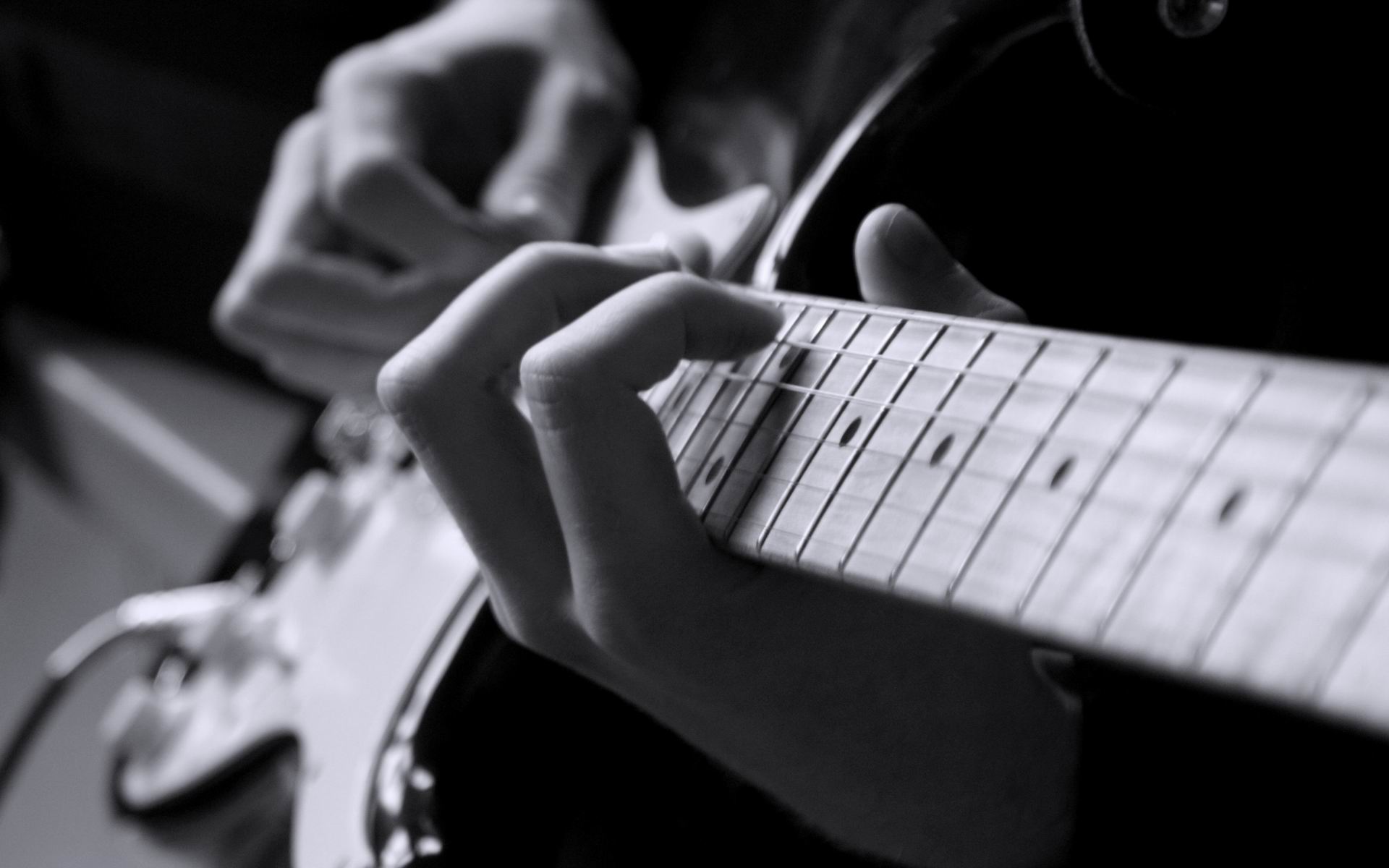Muting the sound of your playing turns the guitar into a more percussive, hard-hitting instrument. Palm muting creates a chugging sound, which is used heavily in genres such as metal, and “dead” strums produce a “thkk” sound, which you can use to build percussive effects into your playing. They’re useful for maintaining a sense of rhythm without being too loud, and they’re great for building energy before an unrestrained chorus. Well-placed mutes are also vital for playing some chords correctly, and help you cut out unwanted noise from accidentally strummed strings.
Fretting Hand Muting, or “Dead” Strums
The easiest mute to perform is a fretting hand mute. This is because it just means touching the strings enough to stop them from vibrating, but not enough to push them down at any specific frets. Simply lay the fingers of your fretting hand down across the strings and then strum. That muted sound is a “dead” strum. If you move your fretting hand further up or down the fretboard, you’ll notice the pitch slightly alter. This is subtle, but it’s important to know that you should generally mute with your fretting hand near the notes you were playing.
Some chords, such as major sevenths, can have strings you don’t play between two that you do. If you catch the extra notes, you’ll ruin the sound of the chord, so fretting hand muting becomes invaluable. You’ll likely be using your index finger in the chord, and if it’s on the lowest fret you need to play you can just gently lay it down across the unwanted strings. Keep the tip pressed down on the note you need, but just touch the ones you want to stay quiet. You can use other fingers to mute specific strings if this technique doesn’t work.
How It Works in Practice
The main way fretting hand muting is used in songs is to keep a beat going without losing it in a mess of constant strumming. Bars in “common” time have space for four quarter-note beats. That means you can fit eight strums of half the length in the same bar. Count “one and two and three and four and” to represent a bar. Fret an A major chord and strum it for every number and each “and.” Play it again, but this time only strum the chord normally on “one,” muting the chord for the remaining seven strums. You keep the rhythm going with your fretting hand, but the chord sticks out more sharply. Keep repeating and add in some extra strums every time you say “three.” You can create a lot of different rhythm sounds just by experimenting with the beats of the bar.
In songs, this can be useful for a verse section where consistently loud guitar would overpower the vocals, or even as an introduction or bridge section. The more frequent the un-muted chords sound out, the more energetic it seems. Start with just one strum per bar, and then add in extra ones gradually to build energy for a chorus. You can use dead strums in riffs or choruses too, but they’re more commonly incorporated into verses.
Picking Hand Muting, or Palm Muting
If you want to create a similar effect to dead strums but not lose the tonal quality of the notes you can use palm muting. This is when you mute the strings with your fretting hand, down near the bridge of the guitar (the structure which lifts the strings up from the body). Lay the pinky edge of your picking hand down across the strings, between the pickups (or sound-hole on an acoustic) and the bridge. Keep your hand in place and pluck a string. If you move your hand closer to the pickups the note becomes more choked and muted, and if you move it closer to the bridge the pitch gets clearer. Experiment with different hand positions to get a sound you like.
The big benefit of palm muting is that the notes are easily identifiable. If you play a bass-line or melody while you’re muting you can still hear the tune, although the sound is notably chunkier. If you want to stop chords from ringing out (for “staccato” play) you can let your picking hand fall against the strings to mute them after each strum.
How it Works in Practice
The fact that the notes still sound out clearly when you palm mute means that it’s often used for entire verse sections in songs. For example, you could write a riff for the introduction and chorus of a song, and then simply palm mute it during the verse to write an easy song. Likewise, in 12 bar blues style progressions the chords are frequently palm muted throughout. You can build energy by moving your hand gradually closer to the bridge before releasing the palm mute for the chorus.
Palm mutes can also be used in the same way as fretting hand muting. If you want to create a more interesting chord progression, you can simply mute the strums on some beats but have a pulse of un-muted strums throughout. Palm muting can also be built into riffs in a similar way, for example, two palm muted chugs of a chord and then a short run of un-muted melody notes. Many players also palm mute any notes on the lower-pitched strings that they play during solos. This keeps the sound tight and stops them from ringing out when you don’t want them to.
Put it to the Test
Now you have a basic understanding of how to perform fretting hand and picking hand mutes, you can start applying them to different situations. Here are some suggestions for how to practice your muting:
- Create a simple metal riff. Choose a chord (a power chord is easier, if you know the shape) and fret it. Mute it twice (either type of muting is fine) and then play normally it the third time. You can repeat it a couple of times at a slower pace or increase the tempo and play it several times. Focus on making every third strum really pop out.
- Learn a scale and play through it with palm muting. Mute the notes on the lower strings and then gradually take it off as you move to the higher ones. You can also try to put the muting back on when you play the scale in reverse.
- Learn the intro to “Voodoo Child (Slight Return)” by Jimi Hendrix or play through “Faith” by George Michael – these both make good use of fretting hand muting. “Voodoo Child” will teach you how to hold a beat with dead strums and “Faith” shows you how to make strumming one chord much more interesting.












Add comment